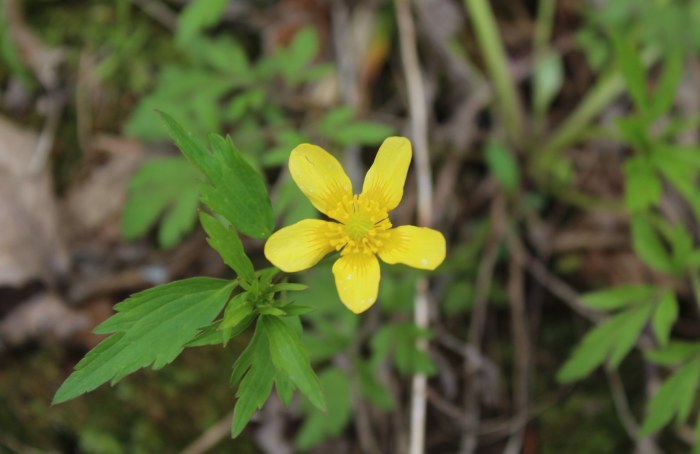If you venture into wet wooded areas in the springtime, there’s a good chance you’ll find some bright yellow flowers. Buttercups can be difficult to distinguish from one another, and multiple sub-species are commonly known as swamp buttercup. I believe the pictures enclosed below are Ranunculus hispidus (hispid buttercup or bristly buttercup).
Some sources refer to a closely related plant as Ranunculus septentrionalis (swamp buttercup), while other sources no longer distinguish between Ranunculus septentrionalis and Ranunculus hispidus. Both species are native to most of the U.S. and Canada east of the Rocky Mountains.
The Illinois Wildflowers website says of swamp buttercup,
This species often grows in soggy areas of woodlands that are too wet for some invasive species, such as Alliaria petiolata (Garlic Mustard). Therefore, populations of Swamp Buttercup remain reasonably secure. This plant is also able to tolerate some degradation of its habitat from other causes.
Incidentally, now would be a good time to pull up garlic mustard if you come across any in nature.
Follow me after the jump for images of swamp buttercup.
The Illinois Wildflowers and Minnesota Wildflowers websites are good resources for botanically accurate descriptions of swamp buttercup foliage and flowers.
Marla Mertz captured these flowers in Marion County.
Sheryl Rutledge gave me permission to publish her pictures, taken in Tama County.
Leland Searles, a specialist on Midwestern botany, provided the next two pictures of Ranunculus hispida. He took these photographs at Timmons Grove Park in Marshall County. He explained,
The Park consists of wooded oxbows and former channels of the Iowa River, some abandoned naturally and some when the river was channelized over a hundred years ago. Swamp Buttercup isn’t especially common there, but it does grow in depressions and the banks of oxbows where sunlight can reach it for part of the day and where soil remains moist through spring.
After a while, the petals of swamp buttercup flowers may turn white. Julie Harkey found this example in Scott County.












1 Comment
Buttercups are so cheering...
..and thank you for these photos that show us why.
I can’t resist sharing a wonderful springtime poem in which buttercups play a role. Thank you, Robert Browning! In Iowa, we could substitute the bluebird for the chaffinch, the yellowthroat for the whitethroat, and the brown thrasher for the thrush.
***
Home-Thoughts from Abroad
Oh, to be in England,
Now that April’s there,
And whoever wakes in England
Sees, some morning, unaware,
That the lowest boughs and the brushwood sheaf
Round the elm-tree bole are in tiny leaf,
While the chaffinch sings on the orchard bough
In England – now!
And after April, when May follows,
And the whitethroat builds, and all the swallows –
Hark! where my blossomed pear-tree in the hedge
Leans to the field and scatters on the clover
Blossoms and dewdrops – at the bent spray’s edge –
That’s the wise thrush; he sings each song twice over,
Lest you should think he never could recapture
The first fine careless rapture!
And though the fields look rough with hoary dew,
All will be gay when noontide wakes anew
The buttercups, the little children’s dower,
– Far brighter than this gaudy melon-flower!
PrairieFan Fri 15 May 3:42 PM